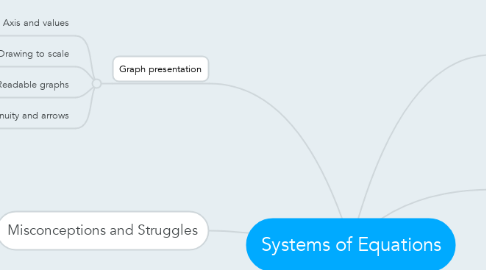
1. Graph presentation
1.1. Labeling Axis and values
1.2. Drawing to scale
1.3. Readable graphs
1.4. Continuity and arrows
2. Misconceptions and Struggles
2.1. The concept of a "linear set of solutions" in an equation such as y=mx+b
2.2. Combining the ideas of solving equations, solving inequalities, and representing that information graphically can be difficult. Pointing out the similarities in these concepts and connecting them to previous ideas such as linear graphing can help students make connections.
2.3. Understanding when to model a set of solutions with an equality vs an inequality can be tricky. Explaining the real world verbiage may be helpful, or just asking students to consider when each might be appropriate could be enough to get them on the right track
3. Real world applications
3.1. What values of this equation might not actually work in reality and why?
3.1.1. Negatives don't work when we are considering positive quantities
3.1.2. We can only use whole numbers when considering whole quantities.
3.2. How can we set up an equation to model these ideas?
3.2.1. Use the process of gathering all the mathematical information we know, stating mathematical relationships, and combining information back together in order to model real world ideas into "math language."
4. Quantitative reasoning
4.1. Example- x+y=7 ->what numbers are possible?
4.1.1. This shows us a line with all values of x and y that could be added together to get seven. There are many 'solutions' that 'satisfy' this equation
5. Systems of Inequalities
5.1. > and < - what values are solutions?
5.2. >+ and <=
5.3. Graphical representations - filling the correct side
5.4. The line is the set of all solutions for a given equation
5.5. The intersection of multiple lines is the set of all solutions for a system of equations
5.5.1. There may be more than one solution, ie, the shaded region may have many solutions inside them
6. Solving systems of equations
6.1. Using Algebra
6.1.1. We can add equations together to solve a system because we are really adding the same thing to both sides, just like we do in single equations
6.2. Graphical Estimation
6.2.1. Not always very precise
6.3. Substitution
6.3.1. Usually the longest and most tedious method
6.4. Direct adding
6.4.1. This is an extension of algebraic processes students already know - where we add one thing to both sides of the equation to keep it balanced. That's why this works.
